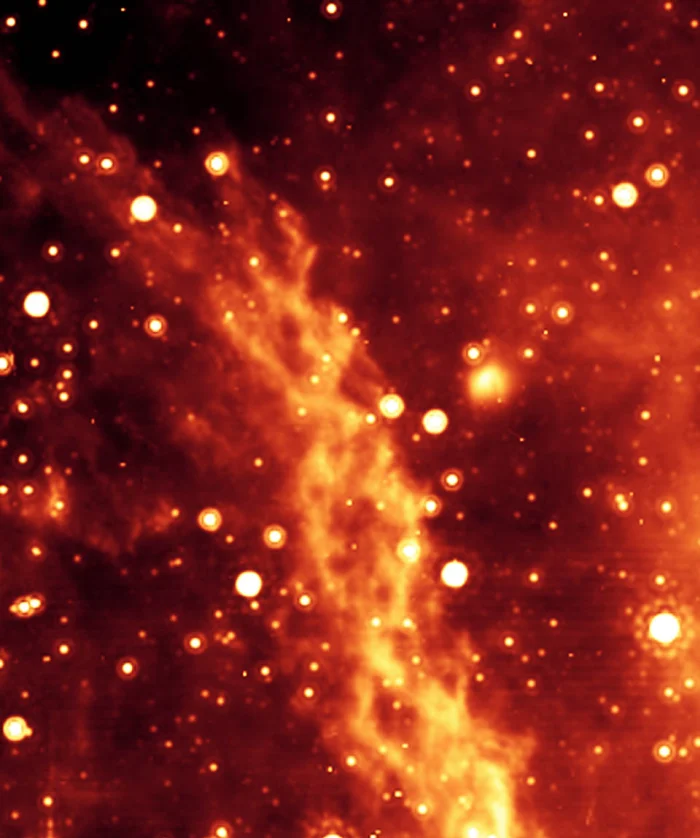The Double Helix Nebula is a gaseous nebula located approximately 25,000 light years from Earth in the constellation Ophiuchus. It lies in the direction of the Galactic centre, 300 light-years from the Milky Way’s central supermassive black hole, Sagittarius A*. The nebula’s axis is oriented perpendicular to the Galactic plane.
The Double Helix Nebula is believed to have been twisted into the shape of a double helix, similar to the shape of a DNA molecule, by magnetic torsion. The center of the Milky Way has a strong, highly ordered magnetic field. The field is strong enough to exert a drag on molecular clouds and affect their orbits. It is oriented along the long axis of the helix.
The twisting of the magnetic field lines at the base sends a magnetic torsional wave that propagates out along the lines. Travelling at around 1,000 km/s, the wave would take about 100,000 years to move from the Galactic centre to where it is now.

The Double Helix Nebula. The spots are infrared-luminous stars, mostly red giants and red supergiants. Many other stars are present in this region, but are too dim to appear even in this sensitive infrared image. The Double Helix Nebula is approximately 300 light-years from the enormous black hole at the center of the Milky Way. (The Earth is more than 25,000 light-years from the black hole at the galactic center.) This image was taken by the Multiband Imaging Photometer for Spitzer (MIPS). Image credit: NASA/JPL-Caltech/M. Morris (UCLA) (PD)
Astronomers believe that the magnetic field lines were not twisted directly by the enormous black hole at the Milky Way’s centre. They are thought to be anchored in the circumnuclear disk of gas that completes an orbit around the black hole every 10,000 years. As the magnetized disk orbits a few light years from the black hole, the magnetic field lines are twisted into the shape of the double helix.
As it moves, the magnetic wave traps small dust particles from the gas disk and carries them. These particles absorb and emit infrared radiation, allowing scientists to observe the wave at infrared wavelengths.
The nebula’s two connected spirals contain red giants and supergiant stars, as well as many stars that are too faint to be detected. The giants and supergiants appear luminous in the infrared.
In 2010, radio polarization measurements led astronomers to hypothesize that the Double Helix is an extension of the polarized northern lobe of the magnetic radio arc. Japanese astronomers Masato Tsuboi, Institute of Space and Astronautical Science (ISAS), Sagamihara, and Toshihiro Handa, Institute of Astronomy, the University of Tokyo, used the Nobeyama 45-m Radio Telescope in Nagano, and identified the Double Helix Nebula as a highly polarized feature at 10 GHz.
The astronomers found that the nebula has a highly ordered magnetic field with synchrotron-emitting relativistic electrons. However, they did not find a clear connection between the circumnuclear disk and the Double Helix in any radio continuum maps. They found that the nebula lies near the galactic northern end of the northern polarized plume, which indicates physical interaction between the nebula and the plume.
In 2014, Enokiya et al. observed the region with the NANTEN2 telescope in the Atacama Desert of northern Chile and found two molecular features with radial velocities of -35 km s-1 and 0 km s-1 that coincided with the Double Helix. The features are about 150 pc across and located at the tops of molecular ridges elongated vertically to the Galactic plane. The team’s findings suggest that both the Double Helix and its molecular counterparts have their origin at the Galactic centre.
In 2014, CO observations with the Caltech Submillimeter Observatory and Mopra telescopes confirmed that the molecular features were associated with the Double Helix Nebula.
Facts
The Double Helix Nebula was discovered by NASA’s Spitzer Space Telescope in 2005. The discovery was announced in the journal Nature. The study was authored by Mark Morris, Department of Physics and Astronomy, University of California (UCLA), Keven Uchida, Cornell University, and Tuan Do, UCLA. The team reported detecting a torsional wave propagating along the strong magnetic field of the Galactic centre. The unprecedented infrared nebula was described as having the morphology of an intertwined double helix.
The helically wound strands are part of a much larger structure interpreted by astronomers as a torsional Alfvén wave that propagates vertically from the galactic disk and is driven by the rotation of the circumnuclear disk orbiting the galaxy’s central black hole. Named after the Swedish plasma physicist Hannes Alfvén, Alfvén waves are plasma waves dominated by fluctuations transverse to the direction of the magnetic field. They are important carriers of magnetic energy.
The observed segment of the Double Helix Nebula was around 25 parsecs (81.5 light-years) in length and contained 1.25 full turns of each of the two strands. The nebula itself extends beyond the observed field. The image of the nebula was captured with the Multiband Imaging Photometer (MIPS) aboard the infrared Spitzer Space Telescope.
The discovery of the Double Helix Nebula provided circumstantial evidence that the magnetic fields at the Milky Way’s centre were over 1,000 times stronger than those of the Sun. They are believed to be driven by the massive circumnuclear disk of gas orbiting the galaxy’s central black hole. However, the direct connection between the disk and the double helix is uncertain.
The Double Helix Nebula is not to be mistaken for the Helix Nebula (NGC 7293, Caldwell 63), a bright, large planetary nebula in the constellation Aquarius. Unlike the Double Helix, NGC 7293 can be observed in small telescopes.